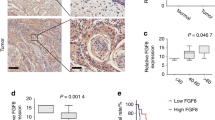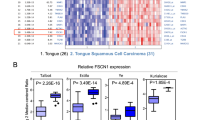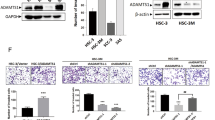Abstract
Matrix metalloproteinase (MMP)-2 plays critical roles in tumor development and in the metastasis of multiple cancers, including human oral cavity squamous cell carcinoma (OCSCC). One of the upstream regulators of MMP-2 is FOXM1, which is overexpressed in a microarray dataset of OCSCC. It is interesting that FLJ10540 exhibits similar gene expression profiles with MMP-2 and FOXM1, raising the possibility that these molecules might participate in MMP-2-elicited cancer progression and metastasis of OCSCC. To examine this connection, we first showed that FLJ10540 was significantly overexpressed in OCSCC. A strong FLJ10540 expression was significantly correlated with an advanced tumor node metastasis stage and the cumulative 5-year survival rate. Thus, an elevated FLJ10540 expression is an indicator of poor survival. Functionally, FLJ10540 had the abilities to stimulate cell migration and invasion in oral cancer cells through increased FOXM1 and MMP-2 expressions. Conversely, the depletion of the FLJ10540 expression by small interefering RNAs suppressed the FOXM1 and MMP-2 protein expressions. The suppression of either FLJ10540 or FOXM1 could cause significant inhibition on cell migratory and invasive ability in oral cancer cells. Finally, the immunohistochemical and western blotting analyses of human aggressive OCSCC specimens showed a significant positive correlation among FLJ10540, FOXM1 and MMP-2 expressions. These findings suggest that FLJ10540 is not only an important prognostic factor but also a new therapeutic target in the FLJ10540/FOXM1/MMP-2 pathway for OCSCC treatment.
This is a preview of subscription content, access via your institution
Access options
Subscribe to this journal
Receive 50 print issues and online access
$259.00 per year
only $5.18 per issue
Buy this article
- Purchase on Springer Link
- Instant access to full article PDF
Prices may be subject to local taxes which are calculated during checkout







Similar content being viewed by others
References
Beenken SW, Urist MM . (2003). Head and neck tumors. In: Way LW, Doherty GM (eds). Current Surgicl Diagnosis and Treatment. McGraw-Hill: New York. pp 282–297.
Bian J, Sun Y . (1997). Transcriptional activation by p53 of the human type IV collagenase (gelatinase A or matrix metalloproteinase 2) promoter. Mol Cell Biol 17: 6330–6338.
Butler GS, Butler MJ, Atkinson SJ, Will H, Tamura T, Schade van Westrum S et al. (1998). The TIMP2 membrane type 1 metalloproteinase ‘receptor’ regulates the concentration and efficient activation of progelatinase A. A kinetic study. J Biol Chem 273: 871–880.
Chan DW, Yu SY, Chiu PM, Yao KM, Liu VW, Cheung AN et al. (2008). Over-expression of FOXM1 transcription factor is associated with cervical cancer progression and pathogenesis. J Pathol 215: 245–252.
Chandu A, Smith AC, Rogers SN . (2006). Health-related quality of life in oral cancer: a review. J Oral Maxillofac Surg 64: 495–502.
Chen CH, Lai JM, Chou TY, Chen CY, Su LJ, Lee YC et al. (2009). VEGFA upregulates FLJ10540 and modulates migration and invasion of lung cancer via PI3K/AKT pathway. PLoS ONE 4: e5052.
Chen CH, Lu PJ, Chen YC, Fu SL, Wu KJ, Tsou AP et al. (2007). FLJ10540-elicited cell transformation is through the activation of PI3-kinase/AKT pathway. Oncogene 26: 4272–4283.
Dai B, Kang SH, Gong W, Liu M, Aldape KD, Sawaya R et al. (2007). Aberrant FoxM1B expression increases matrix metalloproteinase-2 transcription and enhances the invasion of glioma cells. Oncogene 26: 6212–6219.
Fabbro M, Zhou BB, Takahashi M, Sarcevic B, Lal P, Graham ME et al. (2005). Cdk1/Erk2- and Plk1-dependent phosphorylation of a centrosome protein, Cep55, is required for its recruitment to midbody and cytokinesis. Dev Cell 9: 477–488.
Gao ZB, Duan YQ, Zhang L, Chen DW, Ding PT . (2005). Expression of matrix metalloproteinase 2 and its tissue inhibitor in oral squamous cell carcinoma. Int J Mol Med 16: 599–603.
Ginos MA, Page GP, Michalowicz BS, Patel KJ, Volker SE, Pambuccian SE et al. (2004). Identification of a gene expression signature associated with recurrent disease in squamous cell carcinoma of the head and neck. Cancer Res 64: 55–63.
Hardisson D . (2003). Molecular pathogenesis of head and neck squamous cell carcinoma. Eur Arch Otorhinolaryngol 260: 502–508.
Hong SD, Hong SP, Lee JI, Lim CY . (2000). Expression of matrix metalloproteinase-2 and -9 in oral squamous cell carcinomas with regard to the metastatic potential. Oral Oncol 36: 207–213.
Itoh Y, Takamura A, Ito N, Maru Y, Sato H, Suenaga N et al. (2001). Homophilic complex formation of MT1-MMP facilitates proMMP-2 activation on the cell surface and promotes tumor cell invasion. EMBO J 20: 4782–4793.
Jezierska A, Motyl T . (2009). Matrix metalloproteinase-2 involvement in breast cancer progression: a mini-review. Med Sci Monit 15: RA32–RA40.
Kalinichenko VV, Major ML, Wang X, Petrovic V, Kuechle J, Yoder HM et al. (2004). Foxm1b transcription factor is essential for development of hepatocellular carcinomas and is negatively regulated by the p19ARF tumor suppressor. Genes Dev 18: 830–850.
Kamat AA, Fletcher M, Gruman LM, Mueller P, Lopez A, Landen Jr CN et al. (2006). The clinical relevance of stromal matrix metalloproteinase expression in ovarian cancer. Clin Cancer Res 12: 1707–1714.
Kato Y, Uzawa K, Saito K, Nakashima D, Kato M, Nimura Y et al. (2006). Gene expression pattern in oral cancer cervical lymph node metastasis. Oncol Rep 16: 1009–1014.
Khoury H, Naujokas MA, Zuo D, Sangwan V, Frigault MM, Petkiewicz S et al. (2005). HGF converts ErbB2/Neu epithelial morphogenesis to cell invasion. Mol Biol Cell 16: 550–561.
Kim IM, Ackerson T, Ramakrishna S, Tretiakova M, Wang IC, Kalin TV et al. (2006). The forkhead box m1 transcription factor stimulates the proliferation of tumor cells during development of lung cancer. Cancer Res 66: 2153–2161.
Kinoshita T, Sato H, Okada A, Ohuchi E, Imai K, Okada Y et al. (1998). TIMP-2 promotes activation of progelatinase A by membrane-type 1 matrix metalloproteinase immobilized on agarose beads. J Biol Chem 273: 16098–16103.
Lev DC, Onn A, Melinkova VO, Miller C, Stone V, Ruiz M et al. (2004). Exposure of melanoma cells to dacarbazine results in enhanced tumor growth and metastasis in vivo. J Clin Oncol 22: 2092–2100.
Lo WL, Kao SY, Chi LY, Wong YK, Chang RC . (2003). Outcomes of oral squamous cell carcinoma in Taiwan after surgical therapy: factors affecting survival. J Oral Maxillofac Surg 61: 751–758.
Madureira PA, Varshochi R, Constantinidou D, Francis RE, Coombes RC, Yao KM et al. (2006). The forkhead box M1 protein regulates the transcription of the estrogen receptor alpha in breast cancer cells. J Biol Chem 281: 25167–25176.
Martinez-Garay I, Rustom A, Gerdes HH, Kutsche K . (2006). The novel centrosomal associated protein CEP55 is present in the spindle midzone and the midbody. Genomics 87: 243–253.
Mertens PR, Harendza S, Pollock AS, Lovett DH . (1997). Glomerular mesangial cell-specific transactivation of matrix metalloproteinase 2 transcription is mediated by YB-1. J Biol Chem 272: 22905–22912.
Munshi HG, Wu YI, Ariztia EV, Stack MS . (2002). Calcium regulation of matrix metalloproteinase-mediated migration in oral squamous cell carcinoma cells. J Biol Chem 277: 41480–41488.
Niehrs C, Pollet N . (1999). Synexpression groups in eukaryotes. Nature 402: 483–487.
Olmeda D, Jorda M, Peinado H, Fabra A, Cano A . (2007). Snail silencing effectively suppresses tumour growth and invasiveness. Oncogene 26: 1862–1874.
Park MJ, Kim MS, Park IC, Kang HS, Yoo H, Park SH et al. (2002). PTEN suppresses hyaluronic acid-induced matrix metalloproteinase-9 expression in U87MG glioblastoma cells through focal adhesion kinase dephosphorylation. Cancer Res 62: 6318–6322.
Parkin DM, Bray F, Ferlay J, Pisani P . (2005). Global cancer statistics, 2002. CA Cancer J Clin 55: 74–108.
Patel BP, Shah SV, Shukla SN, Shah PM, Patel PS . (2007). Clinical significance of MMP-2 and MMP-9 in patients with oral cancer. Head Neck 29: 564–572.
Qin H, Sun Y, Benveniste EN . (1999). The transcription factors Sp1, Sp3, and AP-2 are required for constitutive matrix metalloproteinase-2 gene expression in astroglioma cells. J Biol Chem 274: 29130–29137.
Rao JS . (2003). Molecular mechanisms of glioma invasiveness: the role of proteases. Nat Rev Cancer 3: 489–501.
Ruokolainen H, Paakko P, Turpeenniemi-Hujanen T . (2004). Expression of matrix metalloproteinase-9 in head and neck squamous cell carcinoma: a potential marker for prognosis. Clin Cancer Res 10: 3110–3116.
Ruokolainen H, Paakko P, Turpeenniemi-Hujanen T . (2006). Tissue and circulating immunoreactive protein for MMP-2 and TIMP-2 in head and neck squamous cell carcinoma—tissue immunoreactivity predicts aggressive clinical course. Mod Pathol 19: 208–217.
Sakai M, Shimokawa T, Kobayashi T, Matsushima S, Yamada Y, Nakamura Y et al. (2006). Elevated expression of C10orf3 (chromosome 10 open reading frame 3) is involved in the growth of human colon tumor. Oncogene 25: 480–486.
Steeg PS . (2003). Metastasis suppressors alter the signal transduction of cancer cells. Nat Rev Cancer 3: 55–63.
Strongin AY, Collier I, Bannikov G, Marmer BL, Grant GA, Goldberg GI . (1995). Mechanism of cell surface activation of 72-kDa type IV collagenase. Isolation of the activated form of the membrane metalloprotease. J Biol Chem 270: 5331–5338.
Sudbo J, Reith A . (2005). The evolution of predictive oncology and molecular-based therapy for oral cancer prevention. Int J Cancer 115: 339–345.
Werner JA, Rathcke IO, Mandic R . (2002). The role of matrix metalloproteinases in squamous cell carcinomas of the head and neck. Clin Exp Metastasis 19: 275–282.
Xie TX, Wei D, Liu M, Gao AC, Ali-Osman F, Sawaya R et al. (2004). Stat3 activation regulates the expression of matrix metalloproteinase-2 and tumor invasion and metastasis. Oncogene 23: 3550–3560.
Yu CT, Hsu JM, Lee YC, Tsou AP, Chou CK, Huang CY . (2005). Phosphorylation and stabilization of HURP by Aurora-A: implication of HURP as a transforming target of Aurora-A. Mol Cell Biol 25: 5789–5800.
Zhao WM, Seki A, Fang G . (2006). Cep55, a microtubule-bundling protein, associates with centralspindlin to control the midbody integrity and cell abscission during cytokinesis. Mol Biol Cell 17: 3881–3896.
Acknowledgements
This work was supported by the grants from the Chang Gung Memorial Hospital, Taiwan (grant numbers CMRPG860512, CMRPG870281, and CMRPG870282), and NSC 97-2314-B-182A-065 and in part by grants from NSC97-2627-B-010-011, NSC97-3112-B-010-025-CC1 (National Science Council) and the Program for Promoting Academic Excellence of Universities (National Yang Ming University) to Chi-Ying F Huang. We thank Dr Wen-Chun Hung, for providing the MMP-2 luciferase plasmids.
Author information
Authors and Affiliations
Corresponding authors
Additional information
Supplementary Information accompanies the paper on the Oncogene website (http://www.nature.com/onc)
Rights and permissions
About this article
Cite this article
Chen, CH., Chien, CY., Huang, CC. et al. Expression of FLJ10540 is correlated with aggressiveness of oral cavity squamous cell carcinoma by stimulating cell migration and invasion through increased FOXM1 and MMP-2 activity. Oncogene 28, 2723–2737 (2009). https://doi.org/10.1038/onc.2009.128
Received:
Revised:
Accepted:
Published:
Issue Date:
DOI: https://doi.org/10.1038/onc.2009.128
Keywords
This article is cited by
-
Evaluation of CEP55, SERPINE1 and SMPD3 genes and proteins as diagnostic and prognostic biomarkers in gastric carcinoma in Egyptian patients
Beni-Suef University Journal of Basic and Applied Sciences (2022)
-
CEP55 promotes epithelial–mesenchymal transition in renal cell carcinoma through PI3K/AKT/mTOR pathway
Clinical and Translational Oncology (2019)
-
Transcriptome reprogramming by cancer exosomes: identification of novel molecular targets in matrix and immune modulation
Molecular Cancer (2018)
-
SPAG5 interacts with CEP55 and exerts oncogenic activities via PI3K/AKT pathway in hepatocellular carcinoma
Molecular Cancer (2018)
-
Centrosomal protein 55 activates NF-κB signalling and promotes pancreatic cancer cells aggressiveness
Scientific Reports (2017)



